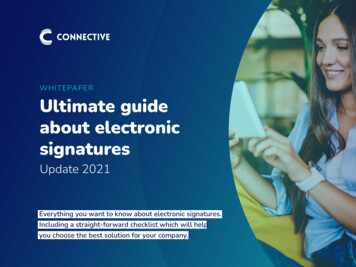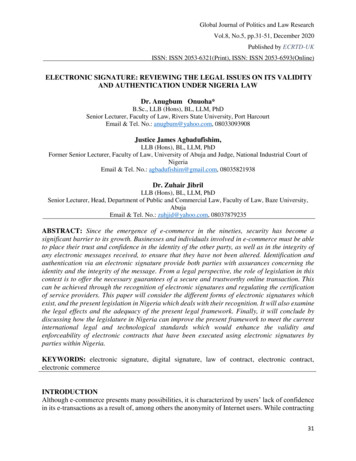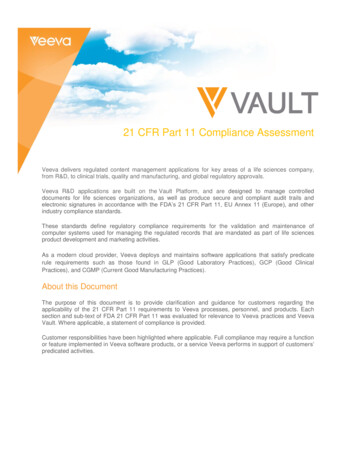
Transcription
Presenting a live 90-minute webinar with interactive Q&AElectronic Contracts and E-Signatures:Complying With ESIGN and the UETA,Interplay With the UCCNavigating Issues of Enforceability, Authentication and AdmissibilityTUESDAY, MARCH 6, 20181pm Eastern 12pm Central 11am Mountain 10am PacificToday’s faculty features:Brian T. Casey, Partner, Locke Lord, AtlantaElizabeth B. Shirley, Partner, Burr & Forman, Birmingham, Ala.Ed Snow, Partner, Burr & Forman, AtlantaThe audio portion of the conference may be accessed via the telephone or by using your computer'sspeakers. Please refer to the instructions emailed to registrants for additional information. If youhave any questions, please contact Customer Service at 1-800-926-7926 ext. 1.
Tips for Optimal QualityFOR LIVE EVENT ONLYSound QualityIf you are listening via your computer speakers, please note that the qualityof your sound will vary depending on the speed and quality of your internetconnection.If the sound quality is not satisfactory, you may listen via the phone: dial1-866-961-8499 and enter your PIN when prompted. Otherwise, pleasesend us a chat or e-mail sound@straffordpub.com immediately so we can addressthe problem.If you dialed in and have any difficulties during the call, press *0 for assistance.Viewing QualityTo maximize your screen, press the F11 key on your keyboard. To exit full screen,press the F11 key again.
Continuing Education CreditsFOR LIVE EVENT ONLYIn order for us to process your continuing education credit, you must confirm yourparticipation in this webinar by completing and submitting the AttendanceAffirmation/Evaluation after the webinar.A link to the Attendance Affirmation/Evaluation will be in the thank you emailthat you will receive immediately following the program.For additional information about continuing education, call us at 1-800-926-7926ext. 2.
Program MaterialsFOR LIVE EVENT ONLYIf you have not printed the conference materials for this program, pleasecomplete the following steps: Click on the symbol next to “Conference Materials” in the middle of the lefthand column on your screen. Click on the tab labeled “Handouts” that appears, and there you will see aPDF of the slides for today's program. Double click on the PDF and a separate page will open. Print the slides by clicking on the printer icon.
Electronic Contracts and E-Signatures:Complying With ESIGN and UETA andInterplay With the UCC.Navigating Issues of Enforceability,Authentication and Admissibility.5
What We Will Cover TodayI.Electronic Signatures/Contracts--What Are They?II.Interplay of ESIGN, UETA and the UCC.III.Relevance to Blockchain Applications.IV.Regulatory Developments and Relevant Case Law.V.Relevant Case Law Concerning Provisions andPractices to Ensure Validity of ElectronicSignatures/Contracts.VI.Enforceability, Authentication and AdmissibilityChallenges with Electronic Signatures/Contracts.6
I.Electronic Signatures/Contracts--What AreThey? (Ed Snow) Some states (NY, IL, and WA) insisted on their own lawsrather than follow NCCUSL. Concerned that state e-commerce law was not going tobe uniform enough, the federal government enacted in2000 the Electronic Signatures in Global and NationalCommerce Act (“ESIGN”) ESIGN pre-empted state e-commerce laws that varied incertain ways from UETA.ED SNOWESNOW@BURR.COM7
ESIGN and UETA Key Points1. A record or signature may not be denied legal effect or2.3.4.5.8enforceability solely because it is in electronic form.A contract may not be denied legal effect orenforceability solely because an electronic record wasused in its formation.If a law requires a record to be in writing, an electronicrecord satisfies the law.If a law requires a signature, an electronic signaturesatisfies the law.In a proceeding, evidence of a record or signature maynot be excluded solely because it is in electronic form.
ESIGN and UETA Key PointsUETA and ESIGN do not change contract law. UETA and ESIGN simply supplement contract law, to permitparties to transact business electronically. As supplemented by UETA and ESIGN, the law of contractformation, the basic elements of validity and verification ofsignatures continue in the electronic signature realm, albeitwith some additional considerations. Accordingly, pre-ESIGN and UETA signature law continuesto apply, other than to the medium.9
Pre-ESIGN and UETA law of signatures. Per the statute of frauds, certain contracts areenforceable only if there is a written memorandum ofthe contract signed by or on behalf of the party to becharged Key issue is intent, not the form the signature takes. A signature may be any symbol made or adopted with anintention, actual or apparent, to authenticate the writingas that of the signer. A signature stamp or machine, if authorized, is asignature.10
Pre-ESIGN and UETA cases. Griffith v. Bonawitz, 103 N.W. 327 (Neb. 1905). “A'signature' is whatever mark, symbol, or device one maychoose to employ as representative of himself.” Parma Tile Mosaic & Marble Co., Inc. v. Estate of Short, 87NY2d 524 (Ct. App. NY 1996). Fax transmission of aguaranty (with no manual signature) with a name pageheader at the top of each page not “subscribed” forpurposes of the Statute of Frauds.Again, the key issue is intent, not the form the signaturetakes.11
ESIGN/UETA Application and ScopeUETA/ESIGN Apply only to “electronic records and electronic signaturesrelating to a transaction.” “Transaction” means “an action or set of actions occurringbetween two or more persons relating to the conduct ofbusiness, commercial, or governmental affairs.” Applies “only to transactions between parties each ofwhich has agreed to conduct transactions by electronicmeans.”12
Exclusions under ESIGN and UETA The UCC, except Section 1-107 (Waiver of Renunciation ofClaim or Right After Breach), Section 1-206 (Statute ofFrauds for Kinds of Personal Property Not OtherwiseCovered), Article 2 (Sales), and Article 2A (Leases). Laws regarding wills, codicils, and testamentary trusts. Other laws (e.g., notice of the cancellation or terminationof utility services; certain notices of default, etc., inconsumer transactions; notice of the cancellation ortermination of health or life insurance benefits; andnotice of the recall of a product, or material failure of aproduct, that risks endangering health or safety, amongothers).13
Electronic Signatures: Key DefinitionsWhat is “electronic”? Relating to technology having electrical, digital,magnetic, wireless, optical, electromagnetic, or similarcapabilities.What is an “electronic signature”? An electronic sound, symbol, or process attached to orlogically associated with a record and executed oradopted by a person with the intent to sign the record.It includes a digital signature.14
Electronic v. Digital SignaturesA digital signature is like a “fingerprint” that is digitallyinserted into an electronic record to identify a signer, notmerely a cut and paste of the image of a manual signature.In order to use a digital signature, the signer would possesscertificate-based digital identification that associates thesigner and the electronic record.15
Electronic v. Digital SignaturesA digital certificate is similar to a physical form ofidentification, such as a passport or driver’s license.Digital certificates are issued by certification authoritieswho provide users with dual digital keys: a private key anda public key. The format for this is called, simply enough, a"public key infrastructure" (or PKI) and provides the highestlevel of security for an electronic signature.16
Electronic v. Digital SignaturesUETA is not a digital signature statute, and nothing in UETArequires the use of a digital signature or any securityprocedure. It is technologically neutral.Parties may use the most up-to-date digital signaturetechnology, or even less sophisticated security proceduressuch as PIN numbers. Whatever parties use for attributionor assuring message integrity may be offered into evidence,unless validly contested.17
Electronic Transactions and RecordsWhat is a “transaction”? An action or set of actions occurring between two ormore persons relating to the conduct of business,commercial, or governmental affairs.What is a “record”? Information that is inscribed on a tangible medium orthat is stored in an electronic or other medium and isretrievable in perceivable form.18
Electronic Transactions and RecordsWhat is an “electronic record”? A record created, generated, sent, communicated,received, or stored by electronic means.Comment 6 to UETA Section 2:“Information processing systems, computer equipmentand programs, electronic data interchange, electronicmail, voice mail, facsimile, telex, telecopying, scanning,and similar technologies all qualify as electronic underthis Act.”19
II. Interplay of ESIGN, UETA and the UCC (Ed Snow)ESIGN/UETA exclude the UCC, except: Section 1-107 (Waiver of Renunciation of Claim or RightAfter Breach), Section 1-206 (Statute of Frauds for Kinds of PersonalProperty Not Otherwise Covered), Article 2 (Sales), and Article 2A (Leases).20
Therefore, for instance, security agreements under UCCArticle 9 and negotiable instruments under UCC Article 3are excluded.BUT agreements for the sale of goods under UCC Article 2(unless disguised security agreements under Article 9) andleases of goods under UCC Article 2A (unless disguisedsecurity agreements under Article 9) are included.21
UCC Article 9 “Electronic Record” Provisions.A security agreement is governed by UCC Article 9 whichhas its own provisions--if less explicit than those set forth inUETA--supporting the creation of an "electronic securityagreement" as a functional security agreement.22
UCC Article 9 “Electronic Record” Provisions.UCC 9-102(a)(7) includes the term "authenticate" which isused with respect to the execution and delivery of asecurity agreement and includes both a written signatureand a digital or electronic signature.“Authenticate” means: (A) to sign; or (B) with present intentto adopt or accept a record, to attach to or logicallyassociate with the record an electronic sound, symbol ofprocess. This language mirrors ESIGN/UETA.23
UCC Article 9 “Electronic Record” Provisions.A "record" includes a security agreement and is definedunder UCC 9-102(a)(70) as follows, also mirroringcomparable language used for "electronic record" in UETA:“information that is inscribed on a tangible medium orwhich is stored in an electronic or other medium and isretrievable in perceivable form.”24
UCC Article 9 “Electronic Record” Provisions.A security interest may attach to personal property whena security agreement becomes effective, that is, when,under UCC 9-203(b)(3)(A): “The debtor has authenticateda security agreement that provides a description of thecollateral .”Under Article 9 the parties to a security agreement donot have to agree to conduct transactions by electronicmeans, but rather the execution and delivery of asecurity agreement itself is an agreement, solely withrespect to the security agreement, to conduct thattransaction by electronic means.25
Transferable Records:A Quasi Exception to the UCC Article 3 ExclusionThe term "electronic record" includes as a subset thereofcalled a "transferable record" which is defined in UETASection 16(a) as "an electronic record that:1. would be a note under [Article 3 of the UniformCommercial Code] or a document under [Article 7 ofthe Uniform Commercial Code] if the electronic recordwere in writing; and2. the issuer of the electronic record expressly hasagreed is a transferable record."26
A party has "control" over a transferable record--grantingsuch party with many of the rights of a holder in due courseunder UCC Article 3--if the conditions of UETA Sections16(b) or (c) are met:(b) [General rule: control of transferable record.] Aperson has control of a transferable record if a systememployed for evidencing the transfer of interests in thetransferable record reliably establishes that person as theperson to which the transferable record was issued ortransferred.27
(c) [Safe harbor rule: control of transferable record.] A person is deemed to have control of a transferable record, ifthe transferable record is created, stored, and assigned insuch a manner that:(1) a single authoritative copy of the transferable recordexists which is unique, identifiable [with exceptions below];(2) the authoritative copy identifies the person assertingcontrol ;(3) the authoritative copy is communicated to andmaintained by the person asserting control or itsdesignated custodian;28
(4) copies or revisions that add or change an identifiedassignee of the authoritative copy can be made only withthe consent of the person asserting control;(5) each copy of the authoritative copy and any copy ofa copy is readily identifiable as a copy that is not theauthoritative copy; and(6) any revision of the authoritative copy is readilyidentifiable as authorized or unauthorized.29
Transferable Record—Perfection v. ControlOfficial Comment 6 to UETA Section 16: “A transferable record under Section 16 would be an‘account,’ ‘general intangible,’ or ‘payment intangible’under Article 9 of the Uniform Commercial Code.” “Therefore, reading the UCC and UETA together it is clearthat under UCC Article 9 a secured party may perfectagainst electronic records (including transferable records)by filing under UCC Section 9-312(a).”30
Transferable Record—IssuanceAn "electronic promissory note" that is intended to havethe benefits of being a transferable record (with many ofthe rights of a holder in due course under UCC Article 3)rather than just merely an electronic record can only becreated if the maker expressly agrees within the terms ofsuch "electronic promissory note" that the same is issuedas a transferable record.31
An Example of Interplay: Commercial Loan Closings? While the law has permitted electronic commercial loanclosings since the late 1990s in most cases, commerciallenders have yet to fully embrace electronic closings, withtoday’s “dual track closings” with emailed PDFs to fundfollowed by wet signatures embracing the new law solong as it is backstopped by older law. Why haven’t lenders fullycommercial loan closings?embracedelectronic Some possible reasons for not closing commercial loanssolely by electronic means:32
UETA, ESIGN, UCC and Commercial Loan Closings? Some lenders won’t fund without an inked promissorynote (even if UCC Article 3 is irrelevant). Some lenders must physically pledge an inked note to afunding source as collateral. Electronic record system long-term preservation andintegrity capabilities/cybersecurity issues. Fear that courts will not find electronic signaturesattributable to the party to be charged.33
UETA, ESIGN, UCCand Commercial Loan DocumentsLoan Documents Covered by UETA (so long as the partiesthereto have agreed to conduct business by electronicmeans):34
UETA, ESIGN, UCCand Commercial Loan DocumentsLoan Agreement:A customary commercial loan agreement, even if it containsa promise to pay the loans advanced under and governedby its terms, is highly unlikely to be a negotiable instrumentunder UCC Article 3, and, is therefore an ordinary contractthat is not excluded under the terms of UETA.35
UETA, ESIGN, UCCand Commercial Loan DocumentsPromissory Note: Excluded if negotiable (i.e., covered by UCC Article 3). If non-negotiable (i.e., not covered by UCC Article 3),then it is NOT excluded under UETA and mayconstitute an electronic record (or a transferrablerecord, if not scanned). In other words, if issued electronically, it is not anegotiable instrument and may constitute anelectronic record (or a transferrable record, if UETASection 16 is satisfied).36
UETA, ESIGN, UCCand Commercial Loan DocumentsPromissory Note:Care must be taken in drafting a promissory note that ismanually signed in ink and then scanned and relied uponas an electronic record because the destruction or loss ofthe manually-signed-in-ink version might inadvertentlyresult in either: The deemed discharge of the debt evidenced by suchnote under UCC Section 3-604, or The inability to enforce the same as a "lost" note underUCC Section 3-309.37
UETA, ESIGN, UCCand Commercial Loan DocumentsPromissory Note continued:Synovus v. Paczko Bank sued on a line of credit agreement introducinginto evidence an electronic copy thereof. Borrowerclaimed the debt evidenced by such line of credit“note” had been discharged because the paperversion was destroyed. Result? Bank won because the “note” said bank coulddestroy the paper version and retain an electroniccopy, and such retention procedure did not limit oraffect bank's right of enforcement.38
UETA, ESIGN, UCCand Commercial Loan DocumentsGuaranty:Like a loan agreement, a customary guaranty of payment,even if it contains a “primary obligor" promise to pay theloans advanced to the borrower, is not a negotiableinstrument under UCC Article 3, and, is therefore anordinary contract that is not excluded under the terms ofUETA.39
UETA, ESIGN, UCCand Commercial Loan DocumentsMortgage: A mortgage is treated the same under UETA as a loanagreement. However, to be enforceable against thirdparties, including a trustee in bankruptcy, it must beproperly recorded in the applicable land records,which requires a writing unless such jurisdictionallows electronic filings. UETA considered excluding mortgages and other realestate documents from its scope, but then declined todo so.40
UETA, ESIGN, UCCand Commercial Loan DocumentsSecurity Agreement As noted above, a security agreement is governed byUCC Article 9 and is therefore excluded from coverageunder UETA. However, UCC Article 9 has its own provisions--if lessexplicit than those set forth in UETA--supporting thecreation of an "electronic security agreement" as afunctional security agreement.41
Thank YouEd Snowesnow@burr.com42
III. Relevance to Blockchain Applications Regulatory acceptance for regulated industries, especiallyfinancial services Need for new laws? How do e-signature and e-delivery laws apply to blockchaintransactions? AZ’s and NV’s Uniform Electronic Transactions Act’s blockchainamendments― "Blockchain technology" means distributed ledger technology that uses adistributed, decentralized, shared and replicated ledger, which may be public orprivate, permissioned or permissionless, or driven by tokenized crypto economicsor tokenless. The data on the ledger is protected with cryptography, is immutableand auditable and provides an uncensored truth.― "Smart contract" means an event-driven program, with state, that runs on adistributed, decentralized, shared and replicated ledger and that can take custodyover and instruct transfer of assets on that ledger. New similar legislative bills in CA, FL, NE and TN MO’s prohibition on DLT for gun ownership registration43
Relationship of E-Signature Laws to Blockchain Implications of blockchain and smart contract definitions addedto state e-signature laws Delaware has amended its corporate code to facilitateblockchain stock transfers and recordkeeping for DEcorporations Initial coin offerings (ICOs) may drive new blockchain laws Will legislatures and regulators feel the need to imposeconsumer protections for consumer blockchain transactions?44
IV. New State Insurance Code e-DeliveryLaws Primarily driven by Property Casualty Insurance Association of Americaover last 3 years Amended state insurance codes in about 18-20 states Many of these new statutes apply only to property and casualtyinsurance, and some are limited to personal lines property and casualtyinsurance, although UETA remains in play in 47 states Most authorize 3 forms of delivery of insurance transactions records:1.Email delivery if consumer consents2.Website posting if insurer delivers by email to consumer who consents to receive by email notice of websiteposting‒3.45Intended to be secure website posting where customer can access electronic insurance transaction documentWebsite posting of “standard” policy and “endorsements” without non-public personal information if insurerdelivers with declarations page the required website posting notice to consumer
Unique Elements of Insurance Code eDelivery Statutes Voice Recordings: if recorded oral communication can be reliablystored and reproduced by insurer, then it is a writing or signature Verification of Receipt: if insurance law requires insurer to obtainacknowledgment of insured’s receipt of delivered document, e-Deliverypermitted only if e-Delivery method provides for insured’sacknowledgment of receipt Insured’s Consent: while many of these laws require insured’s consentfor non-website posting e-Delivery, they also state that failure to obtaininsured’s consent is not basis for denying legal effectiveness ofinsurance policy e-Delivery satisfies first class mail, certified mail and similar mailingrequirements Some states allow discount to insured for accepting e-Delivery, e.g.,215 IL 5/143.33 and MO 379.01146
Questions & Gray Areas Arising from NewState Insurance Code e-Delivery Laws Relationship between UETA and, in non-UETA states, ESIGN Act Validity of website posting delivery unilaterally by insurer withoutconsent of policyholder Potential ESIGN Act’s preemption in non-UETA state (IL) or whereinsurance code e-Delivery law fails to reference ESIGN Act. Is website posting delivery a new category of record delivery that is notan e-record within UETA or ESIGN Act? Current inability to have national website policy delivery process until allstates have embraced47
Reconciling the e-Posting Statutes (cont’d) To the extent such Insurance Code provisions conflict with an edelivery process consistent with a process permitted by the FederalESIGN Act, such Insurance Code provisions should be preempted. By viewing such Insurance Code provisions as “safe harbor” provisions,one avoids the preemption argument. Some states (e.g., KS Ins. CodeSection 40-5804(m)) expressly state that such e-posting statute in theInsurance Code is supplemental to and is not to limit the provisions ofthe Federal ESIGN Act or the state’s UETA. Thus, if the e-posting provisions in the Insurance Codes do not createadministrative burdens, consider including them in your process. Tothe extent they do create undue burdens, comply with the state UETAlaw or the Federal ESIGN Act, and rely on the safe harbor andpreemption arguments.48
General Dynamics Line of Cases Kerr v. Dillard (D. Kansas) Verizon Communications v. Pizzirani (Federal Court in PA,2006) Bell v. Hollywood Entertainment Corp. (Ohio Appeals Court,2006) Campbell v. General Dynamics (Federal Court of Appeals 1stCircuit, 2005)49
General Dynamics Line of Cases (cont’d) Cases are instructive in designing a process (foremployees or consumers in the new businessprocess). e-Delivery can be effective, regardless of whether the personto be bound actually opens or reads the substantive newterms Critical to the process is masking the significance of the eDelivered document very clear and requiring an affirmativeact to signify acceptance, such as “clicking” I agree Stankiewicz v. Cisco Systems, 2009 U.S. Dist. LEXIS91581, decided September 30, 2009) – “equitable”outcome Reminder that other legal principles still apply50
Point of Sale Process Labajo v. Best Buy Stores (Federal Court NY, 2007) Process involved selling subscriptions by including not-so-conspicuousnotices on printed receipts, when the consumer used the electronicsignature pad to sign for purchases Case was a class action based on improper charges when plaintiff didnot timely cancel “free” subscription The court held the process was flawed because BB did not show thekeypad made clear to the consumer the consequence of signing for a“free” subscriptions BB compounded by not responding to consumer complaints very well Case is noteworthy on the process of making the significance of certainactions very clear and the class action risk51
Thank YouBrian T. Caseybcasey@lockelord.com52
Electronic Contracts and E-Signatures:Complying With ESIGN and UETA andInterplay With the UCCElizabeth Shirleybshirley@burr.com
V. Relevant case lawconcerning provisions andpractices to ensure validityof electronicsignatures/contracts
Relevant case law Courts have enforced shrinkwrap license agreements, clickwrap agreements,and browsewrap licenses. Shrinkwrap license agreements evolved from the early practice ofdisplaying the terms of the license through the plastic wrapping(shrinkwrap) concerning the delivery of software on a CD-ROM or otherphysical media.― The first paragraph of the shrinkwrap agreement typically states thatthe opening of the package indicates acceptance of the licenseterms. Contractual formation was based on the user opening theshrinkwrap plastic and using the software. See Mark A. Lemley,Intellectual Property and Shrinkwrap Licenses, 68 S. CAL. L. REV.1239, 1241 n. 5 (1995).
Relevant case law Additionally, courts have enforced clickwrap agreements,where the terms of the clickwrap license are displayedelectronically, and the user indicates acceptance by clickingthe "I accept" button. Courts generally will enforce these clickwrap agreements aslong as the terms are clear and acceptance is unambiguous,regardless of whether the user actually reads them. SeeRealPage, Inc. v. EPS, Inc., 560 F. Supp. 2d 539, 541 n. 1 (E.D.Tex. 2007); Shlomo Bar-Ayal v. Time Warner Cable, Inc., 2006WL 2990032 (S.D.N.Y. Oct. 16, 2006) (J. Wood) (upholdingenforceability of clickwrap agreement concerning selfinstallation CD-ROM concerning Time Warner).
Relevant case law More recently evolved is the browsewrap agreement, which provides thatinternet users may not use a website unless they agree to the site's terms ofservice. See Ronald J. Mann & Travis Siebeneicher, Just One Click: The Reality ofInternet Retail Contracting, 108 COLUM. L. REV. 984, 990 (2008).
Relevant case law Many courts have found that typing your name at the end of an email is a validsignature. Types of Electronic Signatures, INTERNATIONAL ENCYCLOPEDIA OF LAWS: CYBERLAW, 2013 WL 4299218.An exchange of emails between opposing counsel has been held by courts toform a binding settlement agreement between parties. See Hansen v. RhodeIsland’s Only 24 Hour Truck & Auto Plaza, Inc., 863 F. Supp. 2d 122 (D. Mass.2012).
Relevant case law A.C. Furniture, Inc. v. Arby’s Restaurant Group, Inc., No. 4:14–cv–00029, 2014WL 4961055, at *3-4 (W.D. Va. 2014). The court denied the defendant’s argument that an email failed torepresent a contract between the parties because there was no signedwriting, no exact quantity term listed in the email, and no “meeting ofthe minds” or “intention to be bound.” The Court ultimately held that the email looked enough like a contract tosurvive defendant’s motion to dismiss. Id.
Relevant case law Forcelli v. Gelco Corp., 972 N.Y.S.2d 570, 575 (Sup. Ct. N.Y. App. 2013). The court held that an email message from an automobile insurer's claimsadjuster, confirming an oral settlement between the insurer and theplaintiff, was a binding written settlement agreement and enforceableunder New York's statute. New York's statute, CPLR 2014, permits enforcement of a settlementagreement of a party or his/her attorney if it is in writing and subscribedby the party or his/her attorney.
Relevant case law The court explained that the face-to-face mediation at which settlement wasattempted and the subsequent follow-up telephone calls between the partiessupported the conclusion that there was an intent to subscribe the email. Id.at 575-76. The court held “that where, as here, an email message contains all materialterms of a settlement and a manifestation of mutual accord, and the party tobe charged, or his or her agent, types his or her name under circumstancesmanifesting an intent that the name be treated as a signature, such an emailmessage may be deemed a subscribed writing within the meaning” of the NewYork statute.
Relevant case law Furthermore, the court stressed that the email message in question “set forththe material terms of the agreement, to wit, the acceptance by the plaintiffs'counsel of an offer of 230,000 to settle the case in exchange for a release infavor of the defendants, and contained an expression of mutual assent.Significantly, the settlement was not conditioned on any further occurrence,such as the outcome of the motion for summary judgment or the formalexecution of the release and stipulation of dismissal by these defendants andrelated entities.” Id. at 573.
Relevant case law Clean Properties, Inc. v. Riselli, No. MICV2014–04742, 2014 WL 4082266, at *2(Sup. Ct. Mass. 2014). The court held that the defendant’s “email acceptance of the writtencontract terms proposed by Clean Properties created a written contractwithin the meaning of the mechanic’s lien statute.” By including her typed name in the signature block of the email, thedefendant used the email as her electronic signature, thus binding her tothe contract. Id. The court also noted that the “text of the emails between CleanProperties and Riselli make clear that Riselli intended that her email havethe effect of signing or accepting the written contract terms previouslyproposed by Clean Properties.” Id.
Relevant case law Khoury v. Tomlinson, 518 S.W.3d 568 (Tex. App. Dec. 22, 2016). Khoury was looking to recoup his investment in PetroGulf. Tomlinson, asthe president and CEO of PetroGulf, promised to repay the debt at ameeting with Khoury. Khoury sent an email to Tomlinson summarizing their discussions, whichincluded a detailed schedule of repayment. Tomlinson replied, stating: “We are in agreement.” The email did notinclude Tomlinson’s signature. Tomlinson didn’t make any payments, and Khour
ESIGN/UETA Application and Scope UETA/ESIGN Apply only to electronic records and electronic signatures relating to a transaction. Transaction means an action or set of actions occurring between two or more persons relating to the conduct of business, commercial, or governmental affairs. Applies only to transactions between parties .










